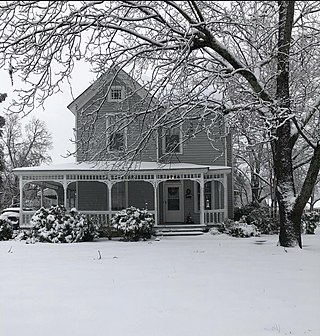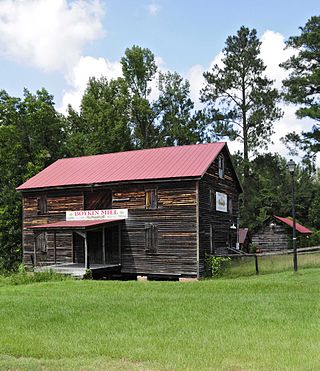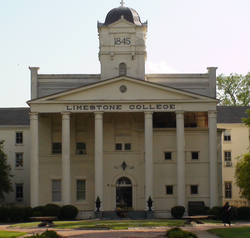
Cherokee County is a county in the U.S. state of South Carolina. As of the 2020 census, the population was 56,216. The county seat is Gaffney. The county was formed in 1897 from parts of York, Union, and Spartanburg counties. It was named for the Cherokee people who historically occupied this area prior to European encounter.

Gaffney is a city in and the seat of Cherokee County, South Carolina, United States, in the Upstate region of South Carolina. Gaffney is known as the "Peach Capital of South Carolina". The population was 12,539 at the 2010 census, with an estimated population of 12,609 in 2019. It is the principal city of the Gaffney, South Carolina, Micropolitan Statistical Area, which includes all of Cherokee County and which is further included in the greater Greenville-Spartanburg-Anderson, South Carolina Combined Statistical Area.

Limestone University, formerly Limestone College, is a private Christian university in Gaffney, South Carolina, United States. It was established in 1845 by Thomas Curtis, a scholar born and educated in England. Limestone was the first women's college in South Carolina and one of the first in the nation; it is the third-oldest college in South Carolina. Ten buildings on the campus, as well as the Limestone Springs and limestone quarry itself, are on the National Register of Historic Places.

Kanuga Conference Center is affiliated with the Episcopal Church in the United States of America and the Anglican Communion. It is located on 1,400 acres (5.7 km2) near Hendersonville, North Carolina, with scenic Kanuga Lake at its center. Yearly, more than 35,000 guests utilize the facilities, which include the conference center, Camp Kanuga, Camp Bob, and the Mountain Trail Outdoor School.

College Hill is a neighborhood in the west central section of the United States city of Greensboro, North Carolina. College Hill was Greensboro's first neighborhood.
William Augustus Edwards, also known as William A. Edwards was an Atlanta-based American architect renowned for the educational buildings, courthouses and other public and private buildings that he designed in Florida, Georgia and his native South Carolina. More than 25 of his works have been listed on the National Register of Historic Places.

Winnie Davis Hall, built in 1904, is an historic redbrick college building on the campus of Limestone College in Gaffney, South Carolina. It was designed by Darlington native William Augustus Edwards, who designed academic buildings at 12 institutions of higher learning as well as 13 courthouses and numerous other buildings in Florida, Georgia and South Carolina. It was named for Varina "Winnie" Anne Davis, the daughter of Jefferson Davis and was built to serve as a repository for American Civil War papers as a center for the study of Southern history. On April 29, 1977, it was added to the National Register of Historic Places. It is part of the Limestone Springs Historic District and is also known as the Winnie Davis Hall of History.

Cowpens Furnace Site (38CK73) is the remains of an early 19th-century iron-making furnace in Cherokee County, South Carolina. The site shows early American iron-making technology. The site was listed on the National Register of Historic Places in 1987.
Archeological Site 38CK1, also known as the Upton Site, is a historic archaeological site located near Gaffney, Cherokee County, South Carolina. The site contains well preserved examples of a specialized soapstone procurement site occupied primarily during the prehistoric, Late Archaic Period. The site is divided into two major areas and the quarry exhibits both historic and prehistoric utilization.
Archeological Site 38CK44, also known as Locus 1, is a historic archaeological site located near Gaffney, Cherokee County, South Carolina. The site contains well preserved examples of a specialized soapstone procurement site occupied primarily during the prehistoric, Late Archaic Period.
Coopersville Ironworks Site (38CK2) and Susan Furnace Site (38CK67), also known as the Cherokee Ford Ironworks Site and Nesbitt Iron Manufacturing Co., is a historic archaeological site located near Gaffney, Cherokee County, South Carolina. The site includes the foundations of four large factory buildings, with a system of canal/sluiceways between them, and the remains of three iron furnaces. The outlying furnace, Susan Furnace, includes foundations, sluiceways, slag heaps, and adjacent ore pits. The complex is the largest and best preserved factory complex of any of the 19th century iron manufacturing companies of the region. The complex was developed between 1835 and 1843 by the Nesbitt Iron Manufacturing Company, the largest iron company in South Carolina. The Nesbitt Company was dissolved in the late 1840s, and the Swedish Iron Manufacturing Company of South Carolina operated the ironworks from 1850 until the American Civil War.
Ellen Furnace Site (38CK68) is a historic archaeological site located near Gaffney, Cherokee County, South Carolina. The site includes a partially collapsed but well-preserved iron furnace constructed about 1838 of quarried stone and two earthen sluiceways. Also present are building foundations, tramway road beds, and ore mines. It is directly associated with the nearby Susan Furnace Site. Both were outlying furnace operations associated with the manufacturing complex at Coopersville owned by the Nesbitt Company and later the Swedish Ironworks. The Coopersville Ironworks along with the Susan and Ellen Furnaces were developed between 1835 and 1843 by the Nesbitt Iron Manufacturing Company, the largest iron company in South Carolina. The Nesbitt Company was dissolved in the late 1840s, and the Swedish Iron Manufacturing Company of South Carolina operated the ironworks from 1850 until the American Civil War.
Nesbitt's Limestone Quarry (38CK69) is a historic archaeological site located near Gaffney, Cherokee County, South Carolina. The site includes the most extensive and best preserved limestone quarry associated with early iron production in the northwestern Piedmont of South Carolina. It was the primary source of limestone for the region's ironworks. Quarrying activity at Nesbitt's ceased in the early part of the 20th century. The site covers approximately 30 acres and has exposed vertical faces of limestone and is located in a large body of limestone that extend in a linear fashion from Limestone College to across the South Carolina state line.

Carnegie Free Library is a historic Carnegie library building located at Gaffney, Cherokee County, South Carolina. It was built in 1913–1914, and is a one-story over raised basement, rectangular red brick Classical Revival style building. It has a gently pitched standing seam metal roof and a brick parapet. In 1937, it was doubled in size by a rear addition. It is one of 14 public libraries built in South Carolina between 1903 and 1916 with funding from Andrew Carnegie and the Carnegie Foundation, and was Gaffney's first public library.

Gaffney Commercial Historic District national historic district located at Gaffney, Cherokee County, South Carolina. The district encompasses 41 contributing building in the central business district of Gaffney. Most of the buildings were built after 1900 and before 1930 and are primarily commercial buildings in vernacular commercial interpretations of the Italianate, Romanesque Revival, Renaissance Revival, Art Deco, and Neoclassical styles. All of the buildings are of brick construction and vary from one to four stories in height. The downtown area, which continues to be a center of Gaffney commerce, retains much of its early 20th century character.

Gaffney Residential Historic District national historic district located at Gaffney, Cherokee County, South Carolina. The district encompasses 111 contributing building in a primarily residential area of Gaffney. The majority of the buildings were built between about 1890 and about 1930, and consist of houses sited on large urban lots and oriented towards wide, tree-lined streets. Homes are generally of frame or brick construction with fine examples of the Queen Anne, Colonial Revival, Neoclassical, Victorian and Bungalow styles as well as traditional vernacular forms. Included in the district are homes of textile mill executives, merchants, and other professionals who lived in Gaffney during its boom period at the turn of the 20th century.

Boykin Mill Complex, also known as Mill Tract Plantation, is a national historic district located near Camden, Kershaw County, South Carolina. The district encompasses nine contributing buildings, two contributing sites, and four contributing structures. “Boykin Mill” denotes a community which consists of an old post office, an old general store, a c. 1905 grist mill, mill pond, mill dam, gates, and canals. The community also includes an early 19th-century Greek Revival style Baptist church, one mid-19th-century residence, three 20th-century residences built for mill workers, and a smoke house. An American Civil War battle site is also a part of the Boykin Mill community. The Battle of Boykin's Mill took place on April 17, 1865.

Columbia Historic District II is a national historic district located at Columbia, South Carolina. The district encompasses 113 contributing buildings and 1 contributing site in a former residential section of Columbia. They were built between the early-19th century and the 1930s and are now mostly used for commercial purposes. The buildings are in the Greek Revival, Gothic Revival, Classical Revival, and the “Columbia Cottage” styles. Notable buildings include the Robert Mills House, Debruhl-Marshall House, Hampton-Preston House, Episcopal Church of the Good Shepherd, Crawford-Clarkson House, Maxcy Gregg House, Hale-Elmore-Seibels House, St. Paul's Lutheran Church, and Ebenezer Lutheran Church.

Mount Pleasant Historic District is a national historic district located at Mount Pleasant, Charleston County, South Carolina. The district encompasses nine contributing buildings in the town of Mount Pleasant. The dwellings reflect Mount Pleasant's historic role as a summer resort town. The building reflect architectural styles of the 18th, 19th and early 20th centuries, including vernacular Georgian, Greek Revival and Gothic Revival. Notable buildings include the Mount Pleasant Presbyterian Church, St. Andrew's Episcopal Church, Mount Pleasant Seventh-Day Adventist Church, Hibben-McIver House, 200 Bank Street, and the Captain Peter Lewis House. Located in the district is the separately listed Old Courthouse.

The Columbia Historic District is a neighborhood in Cedarburg, Wisconsin, that is listed on the National Register of Historic Places. At the time the district was listed on the register, its contributing properties included 128 historic homes, one church, and eighty-seven historic outbuildings, including garages and barns, all constructed between 1844 and 1938. The district also contained several dozen buildings that do not contribute to the historic district, including modern homes from the post-war era as well as modern garages and other additions to historic properties.

















